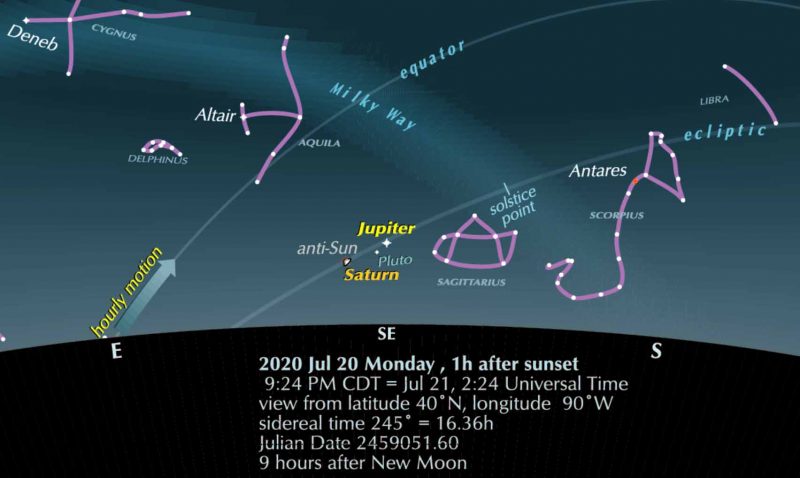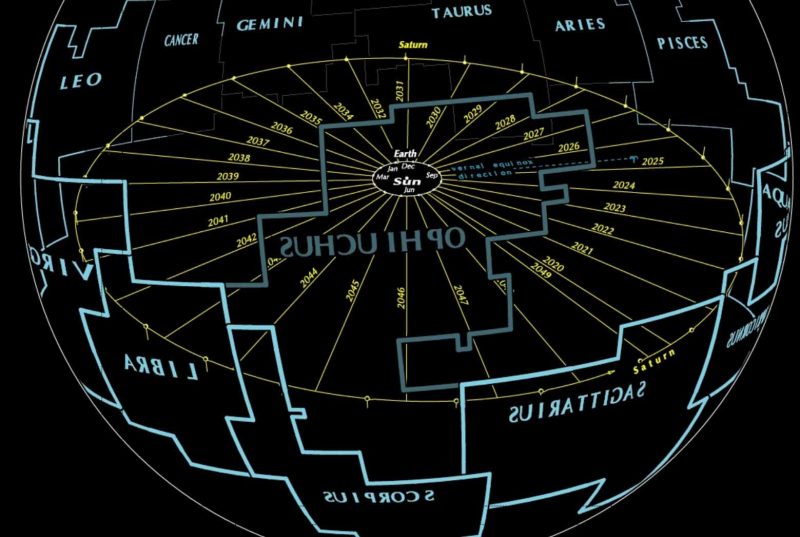
Originally published July 19, 2020, at Guy Ottewell’s blog. Reprinted with permission. Don’t miss Guy’s new book : Venus, A Longer View.
Planet Six – Saturn, long believed to be the outermost planet of our solar system – will be at opposition on July 20, 2020.
The moment of the opposition is July 22, 20 hours UTC – no, July 20, 22 UTC! This is the sort of trap that catches arithmophobes like me, who are liable to show up at 8 on the 9th instead of 9 on the 8th.
And the illustration below shows a space view: a survey of Saturn’s oppositions all around its nearly 30-year orbit, like the picture we showed for Jupiter.
If you look at the Jupiter and Saturn pictures in alternation, remember that the Saturn picture is at a smaller scale, because it reaches out farther.

We think of Jupiter as going around the sun in 12 years and Saturn in 30, so that Jupiter spends one year in each zodiacal constellation, and Saturn spends two and a half years in each. But, more exactly, each of those planets’ orbital periods is a bit shorter than those simple ideals. Jupiter’s is 11.85, and Saturn’s is 29.5.
Thus Jupiter’s course of 2020 is slightly overlapped by its course of 12 years later (2031). And Saturn’s course of 2020 is half overlapped by its course of 30 years later (2049).
Believe me, an arithmophobe has to think carefully to get even those additions right! It would be easier if we were now in the year 2001.
Each successive year, Earth has to go around an extra part of a month to overtake Saturn; so the oppositions move later in the year, until they skip a year. One falls near the end of 2032, so there is none in 2033 and the next is in early 2034.
And, the astronomical constellations being irregular, Saturn has (in this cycle) no opposition in Scorpius and two in Ophiuchus.
In the illustration above, the globes representing Saturn are exaggerated 100 times in size. Stalks from them are perpendicular to the ecliptic plane.
Saturn was at its descending node through the plane only this year, in February, so at opposition it really is almost exactly opposite to the sun – barely south of the anti-sun point. It will ascend through the plane half an orbit later, in June 2034, so that the opposition in January of that year will also be only just south of the ecliptic.
At the present opposite, Saturn’s magnitude is 0.1; it can be as bright as -0.5, as in 2031 and 2032, or as dim as 0.6, as in 2024, 2025, and 2039.
Bottom line: Astronomer Guy Ottewell offers his insights – and chart-making skills – to you during this 2020 opposition of our solar system’s golden and glorious planet of the rings, Saturn.











